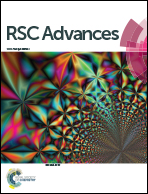Enhanced oxidative and adsorptive capability towards antimony by copper-doping into magnetite magnetic particles†
Abstract
This study compared the removal capability and mechanisms involved in the removal of aqueous Sb by non-doped and Cu-doped Fe3O4 (magnetite). After doping Cu into Fe3O4, it exhibited a smaller particle size with slightly declined saturation magnetization, and enhanced antimony adsorptive capability. Non-doped Fe3O4 showed a maximum adsorption capacity (Qmax) of 34.46 mg Sb(III) g−1 and 7.07 mg Sb(V) g−1 at pH 7.0. The doping of Cu improved the Sb adsorption with a Qmax of 43.55 mg Sb(III) g−1 and 30.92 mg Sb(V) g−1 accordingly. The co-existing sulfate and carbonate had a negligible effect on Sb removal; however, phosphate at 10 mM decreased the Sb(III) and Sb(V) removal by 50.1% and 18.2% for Fe3O4 and by 14.1% and 58.6% for Cu-doped Fe3O4. As for Cu-doped Fe3O4, the results indicated that the Sb(III) oxidation on ![[triple bond, length as m-dash]](https://www.rsc.org/images/entities/char_e002.gif) CuII–O sites was much more significant than that on
CuII–O sites was much more significant than that on ![[triple bond, length as m-dash]](https://www.rsc.org/images/entities/char_e002.gif) FeIII–O sites and the dissolution oxygen amount did not affect this process. Upon the electron transfer from Sb(III) to Cu(II), the formed Cu(I) and Sb(V) tends to release into the solution and the Cu(I) disproportionates to give Cu(II) ions and a precipitate of Cu(0) thereafter. The magnetic Cu-doped Fe3O4 shows good removal efficiency towards both Sb(III) and Sb(V) and is a potential adsorbent for Sb removal in practice.
FeIII–O sites and the dissolution oxygen amount did not affect this process. Upon the electron transfer from Sb(III) to Cu(II), the formed Cu(I) and Sb(V) tends to release into the solution and the Cu(I) disproportionates to give Cu(II) ions and a precipitate of Cu(0) thereafter. The magnetic Cu-doped Fe3O4 shows good removal efficiency towards both Sb(III) and Sb(V) and is a potential adsorbent for Sb removal in practice.


 Please wait while we load your content...
Please wait while we load your content...